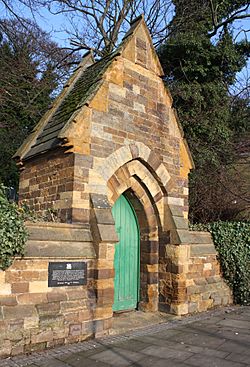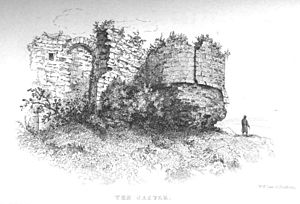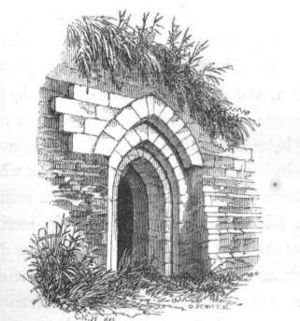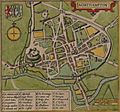Northampton Castle facts for kids
Quick facts for kids Northampton Castle |
|
|---|---|
| Northampton, England | |

All that remains of Northampton Castle: a postern that was dismantled from its original position and rebuilt into the wall of Northampton railway station
|
|
| Coordinates | 52°14′13″N 0°54′18″W / 52.237°N 0.905°W |
| Type | Motte-and-bailey castle |
| Site information | |
| Condition | Destroyed |
| Site history | |
| Built | 1084 |
| Built by | Simon de Senlis |
Northampton Castle was one of the most famous Norman castles in England. Norman castles were built by the Normans, who came from France and conquered England in 1066.
The castle was built just outside the western city gate of Northampton. It was protected on three sides by deep trenches. A part of the River Nene acted as a natural barrier on its western side. The castle had large grounds and a big keep, which is the strongest tower in a castle. Its gates were protected by earth mounds called bulwarks, which were used to hold artillery (large guns).
Sadly, the castle was mostly destroyed in the 1800s. This happened when a railway line, now part of the West Coast Main Line, was built. The original Northampton railway station was built right on the castle's site. Today, the only part of the castle that remains is the Postern Gate. This is a small back gate, and you can find it near Northampton Railway Station.
Contents
History of Northampton Castle
Building the Castle
The castle was started in 1084 by Simon de Senlis. He was the first Earl of Northampton. It took several years to finish building it. This is because it wasn't mentioned in the Domesday Book, a huge survey of England completed in 1086.
Later, during the time of King Henry II, the castle was controlled by the King.
Important Events
In 1164, a very important trial happened at Northampton Castle. Thomas Becket, who was the Archbishop of Canterbury, was tried there by a great council. He managed to escape by dressing as a monk and then fled to France.
In 1264, there were wars between King Henry III and his powerful nobles. During these wars, the castle was owned by the nobles who were fighting the King. It was controlled by Simon de Montfort, a famous leader of the nobles. When the King won, the castle went back to being controlled by the King.
It stayed under the King's control until the reign of King Edward III. At that time, a local official named Thomas Wake, 2nd Baron Wake of Liddell claimed the castle belonged to the county he oversaw.
In 1452, during the reign of King Henry VI, the castle was rented out. Robert Caldecote rented it for 20 years for £5 a year. The rent included the right to fish in the river nearby. By the late 1600s, the castle was owned by Robert Haselrig.
The Castle Disappears
During the Victorian period (the 1800s), railways were built all over England. At first, the main railway line from London didn't go through Northampton. But in 1879, a new loop line was built that went through the town.
To build this railway line and the Northampton Castle railway station, the castle and its foundations were torn down. The only parts that survived were some earth banks and the small postern gate. This gate was moved and rebuilt into a wall near the railway station.
The station was rebuilt again in 1963–64. Before this rebuilding, in 1961, archaeologists dug up the site. They found parts of the castle's defenses from the 1100s. These included a ditch 90 feet wide and 30 feet deep, and a bank 80 feet wide and 20 feet high.
Northampton Castle Today
In the 21st century, a group of volunteers called the Friends of Northampton Castle (FONC) was formed. They work to share information about the castle's history. In 2012, they even created a 3D model of the castle, which you can see online.
Northampton town has been growing, and the railway station needed to be bigger. So, in 2013, work began to expand and rebuild the station. This gave archaeologists another chance to dig up the site. In 2012–13, they found many interesting items from the Anglo-Saxon period, which was before the Normans. These finds included a brooch, pieces of pottery, and an ironstone wall.
Northampton Castle in Stories
Northampton Castle is mentioned in William Shakespeare's play King John. In the play, Prince Arthur, who is King John's young nephew and a claimant to the throne, dies at the castle. The play says he jumps to his death from the castle walls while trying to escape.
In real life, what happened to Prince Arthur is a mystery. He was last known to be a prisoner in Rouen Castle in France in April 1203. It's thought he was killed on King John's orders, but it's more likely he died in France, not England.
Images for kids





